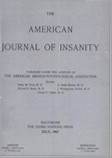A REVIEW OF THE RESULTS FROM THE EMPLOYMENT OF MALARIA THERAPY IN THE TREATMENT OF NEUROSYPHILIS IN THE FLORIDA STATE HOSPITAL
Abstract
The late results from the employment of malaria therapy supplemented by chemotherapy are presented for a series of 190 cases of cerebro-spinal lues, and compared with the condition of 20 concurrent cases, treated by chemotherapy alone.
The present status of the patients in the 2 series is as follows:
Thus 55 per cent of the cases receiving malaria therapy as contrasted with 30 per cent of those receiving chemotherapy alone, show varying degrees of improvement to complete remission, while 45 per cent of the former and 70 per cent of the latter are either unimproved or have since died.
The results from naturally or artificially induced malaria attacks do not appear to be significantly different. The quartan parasite appears to be the most effective agent for producing the requisite number of severe paroxysms.
Best results were secured from the application of malaria therapy to persons under the age of 30. Such patients react favorably to fewer paroxysms than appear necessary to produce comparable results in older persons.
Better results from the standpoint of the remission rate as well as of lower mortality are observed as the number of malaria paroxysms increases, although after 40 paroxysms have been experienced the chief improvement appears to be in the subsequent mortality rate. More striking, however, are the results when considered from the standpoint of the number of severe paroxysms experienced, arbitrarily placed at 104°F. Persons experiencing 21 or more such paroxysms have had a remission rate in excess of 60 per cent with no mortality. Those having II or more have a remission rate of 43 per cent and a mortality of 9 per cent.
It has been assumed that only deaths occurring within one month of the cessation of the attack of induced malaria can fairly be laid to the treatment. Of the 49 reported as deceased only 13 died within that period, which would give a mortality rate of 6.9 per cent.
Better results have been secured from asymptomatic cases than from symptomatic. Of the latter, the cases presenting organic signs only have given better results than those with mental involvement. In the group with mental involvement best results have been secured with the agitated, and poorest results with the depressed cases.
Access content
To read the fulltext, please use one of the options below to sign in or purchase access.- Personal login
- Institutional Login
- Sign in via OpenAthens
- Register for access
-
Please login/register if you wish to pair your device and check access availability.
Not a subscriber?
PsychiatryOnline subscription options offer access to the DSM-5 library, books, journals, CME, and patient resources. This all-in-one virtual library provides psychiatrists and mental health professionals with key resources for diagnosis, treatment, research, and professional development.
Need more help? PsychiatryOnline Customer Service may be reached by emailing [email protected] or by calling 800-368-5777 (in the U.S.) or 703-907-7322 (outside the U.S.).



